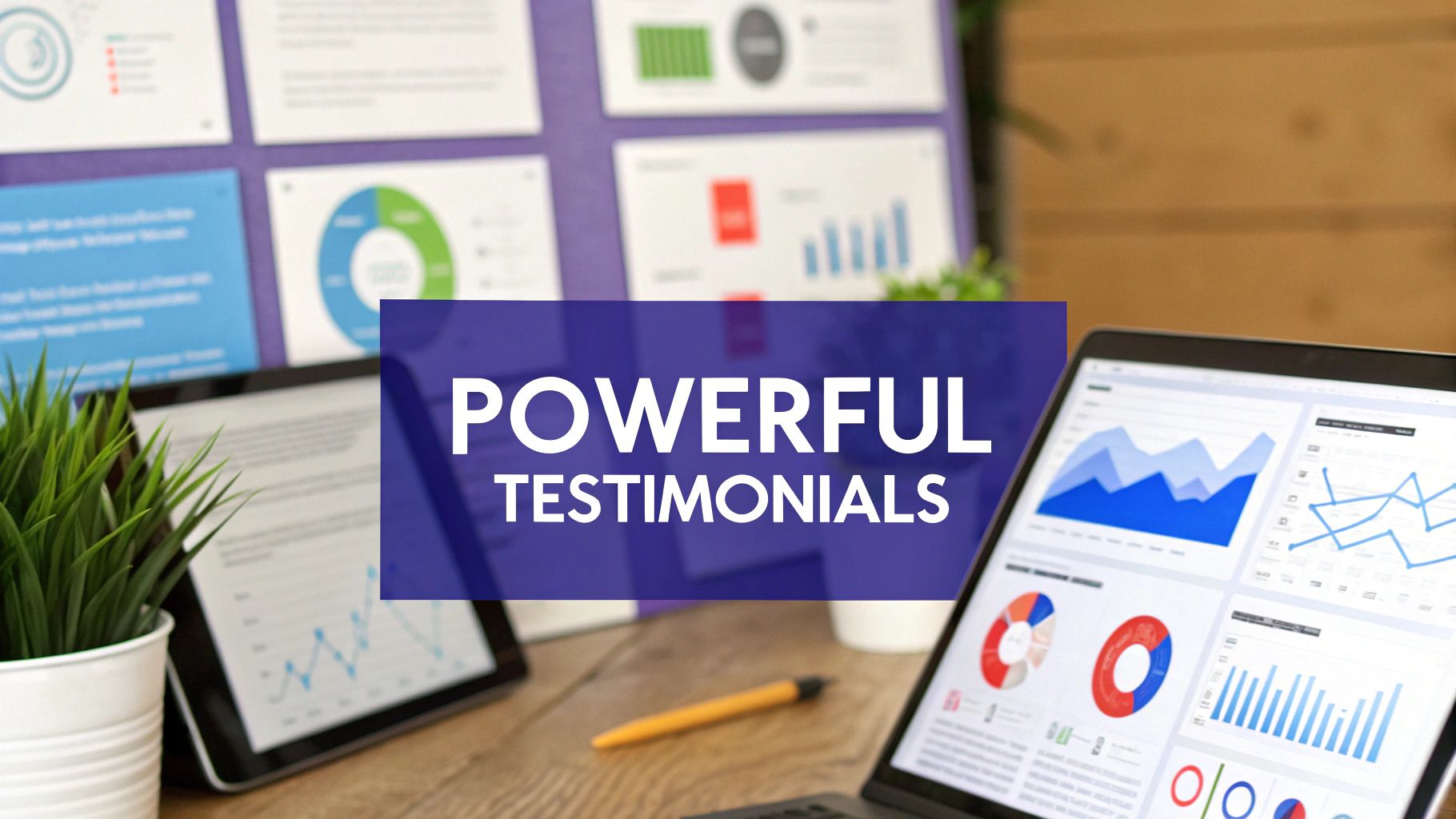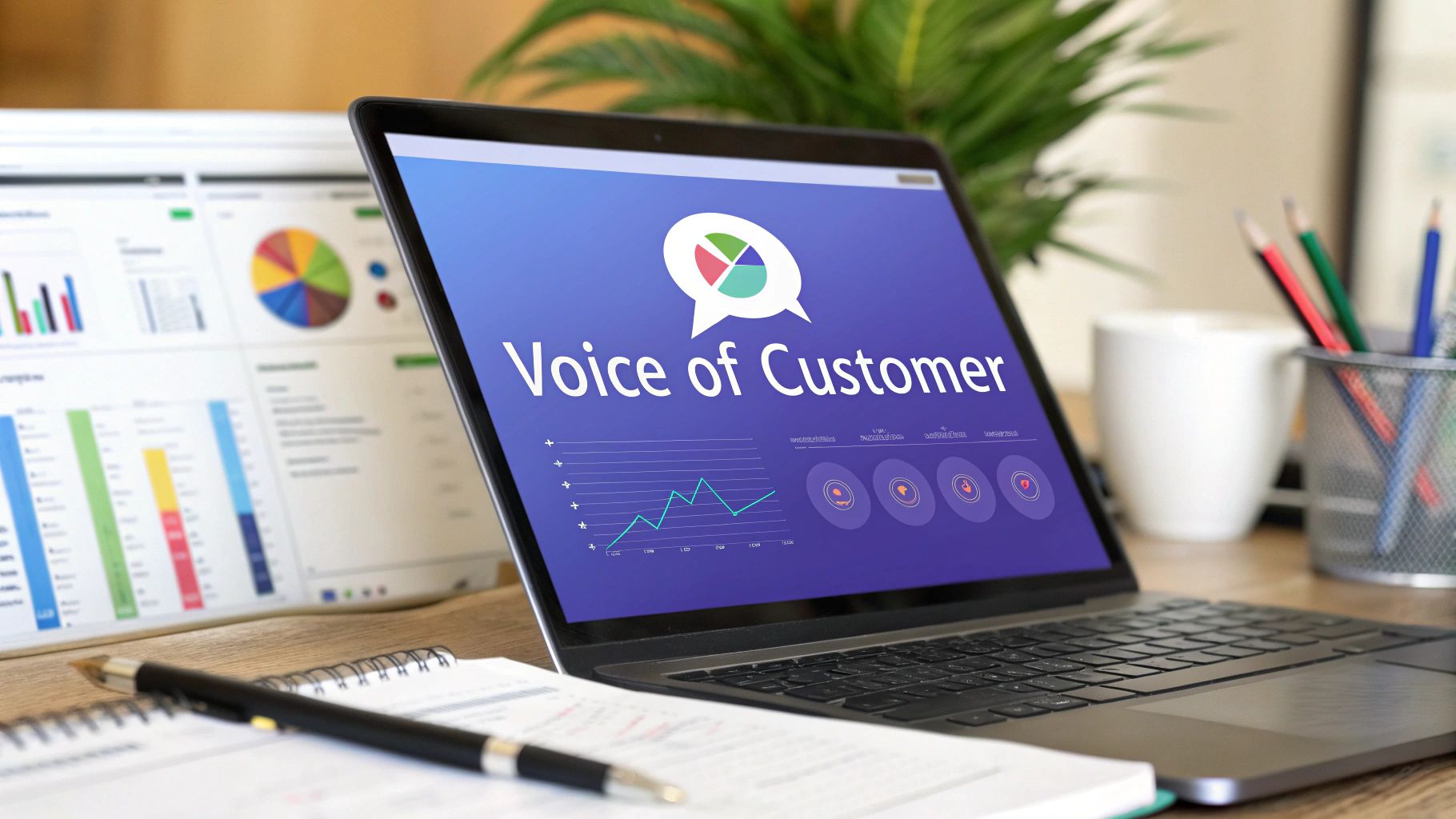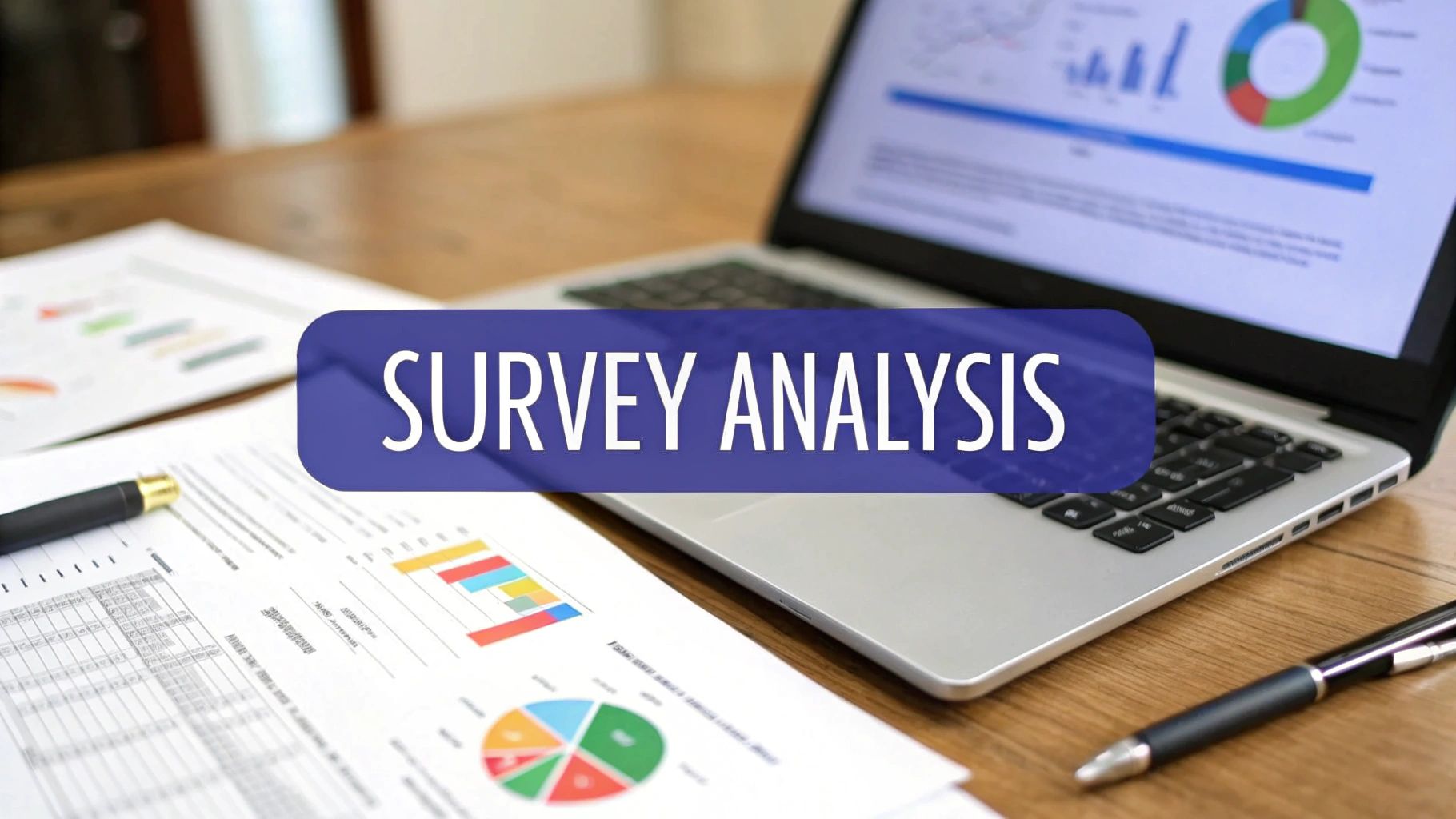9 High-Impact Survey Email Subject Lines for 2025
Boost your response rates with these powerful survey email subject lines. Explore 9 categories with expert analysis and actionable tips to get more feedback.
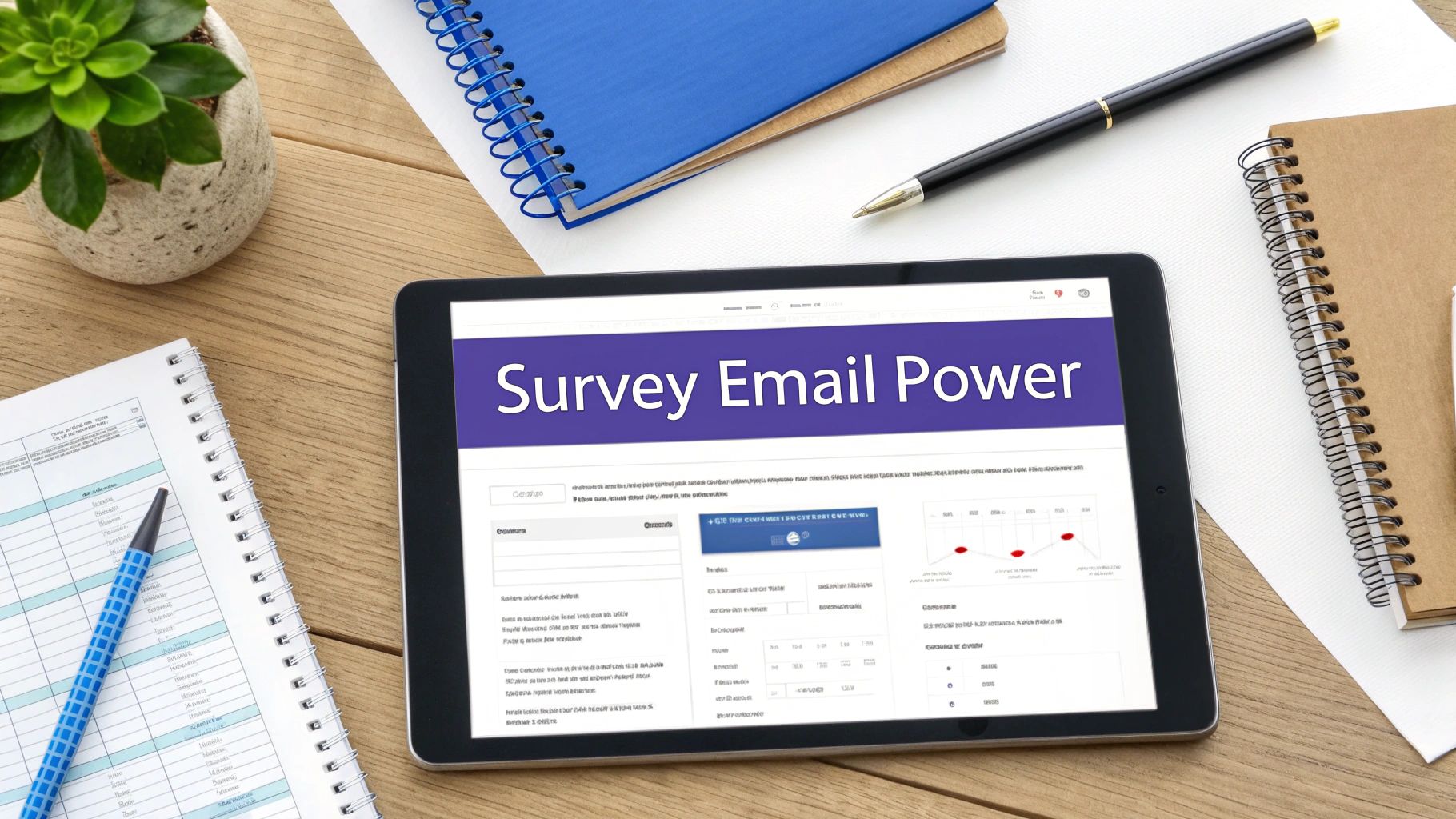
You’ve meticulously designed your survey, crafted thoughtful questions, and identified the perfect audience. You hit send, expecting a flood of valuable data, only to be met with a trickle of responses. The most common culprit is often the very first thing your audience sees: the subject line. This single line of text is the gatekeeper to your survey, determining whether your email gets opened or ignored. A weak subject line means your hard work goes unseen, resulting in low response rates and incomplete data that can't reliably inform your decisions.
This guide moves beyond generic advice to provide a strategic arsenal of high-performing survey email subject lines. We will dissect dozens of examples across key categories, from time-sensitive and personalized approaches to those driven by curiosity and benefits. For each example, we'll break down the underlying psychology, explain why it works, and provide actionable takeaways you can immediately apply to your own campaigns.
The principles behind crafting effective survey email subject lines are closely related to the art of writing compelling headlines that capture attention and drive action. By mastering this crucial first impression, you can significantly boost your open rates, gather more robust feedback, and ultimately make smarter, data-backed decisions for your product, marketing, and customer success strategies.
1. Direct Time-Specified Survey Subject Lines
One of the most effective strategies for crafting compelling survey email subject lines is to be direct and transparent about the time commitment required. This approach immediately addresses a recipient's primary hesitation: "How long will this take?" By stating the expected duration upfront, you eliminate uncertainty, reduce friction, and manage expectations, making contacts significantly more likely to click through and complete your survey.
This method works because it respects the recipient's time. In a crowded inbox, a subject line that promises a quick, defined task stands out as a low-effort, high-value proposition. It frames the survey not as an ambiguous chore, but as a manageable action item.
Strategic Analysis
The core strategy here is transparency. Instead of vague requests like "Share your feedback," which can imply a lengthy commitment, you provide a clear, quantifiable promise. This builds trust from the very first interaction.
Quick 2-minute survey about your experienceGot 5 minutes? Help us improve [Product Name]30-second poll: How did we do today?
Key Insight: Specifying a short duration (under 5 minutes) positions your survey as an easy "yes." It leverages the psychological principle of micro-commitments, where individuals are more willing to agree to a small request, making them more likely to see it through to completion.
Actionable Takeaways
To implement this tactic effectively, focus on accuracy and brevity. Always test your survey to ensure the stated time is realistic, as breaking this promise can damage credibility.
Here are the key points visualized in a quick reference summary box.
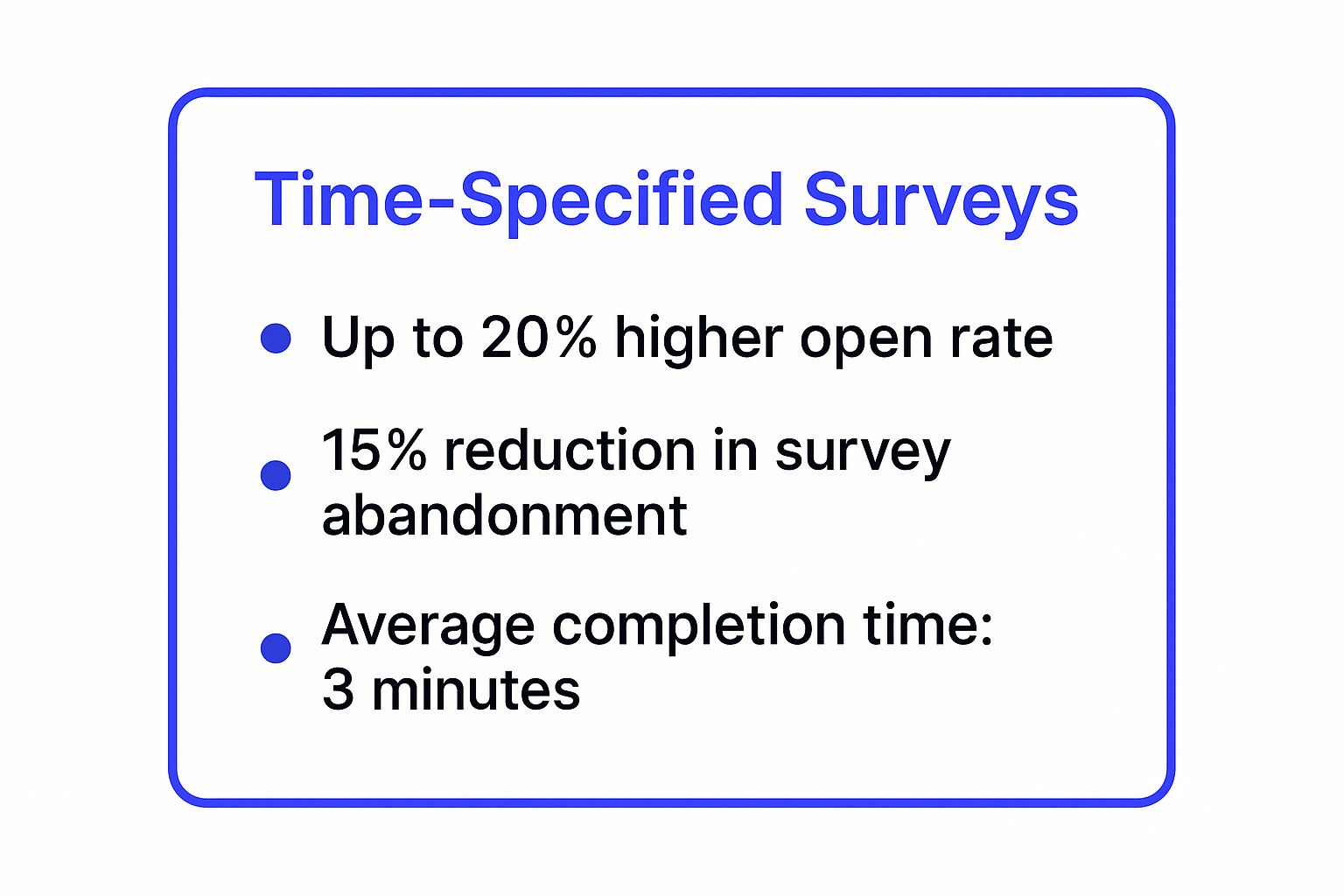
The data clearly indicates that this small adjustment in your survey email subject lines can lead to a substantial boost in engagement and a lower abandonment rate, directly impacting the quality and quantity of feedback you collect.
For more on crafting effective, time-based requests, this video from behavioral science expert Dan Ariely offers valuable insights into human motivation.
2. Personalized Survey Subject Lines
Leveraging personalization is a powerful technique for creating survey email subject lines that command attention and drive action. By incorporating a recipient's name or referencing a recent interaction, you transform a generic broadcast into a personal conversation. This strategy breaks through the noise of a crowded inbox by signaling that the email is specifically for them, not just another mass mailing.
This method works by tapping into fundamental human psychology. Hearing or seeing our own name triggers an immediate, subconscious reaction, making us more receptive to the message that follows. It's a simple yet profound way to build rapport and show your customers that you see them as individuals, not just data points.

Strategic Analysis
The core strategy here is to create a sense of individual recognition and relevance. Instead of a one-size-fits-all request, a personalized subject line feels exclusive and important. This simple act of using customer data thoughtfully demonstrates a more sophisticated and customer-centric approach, which can significantly boost open rates.
John, we'd love your feedback on our serviceSarah, how was your recent purchase experience?Mike, help us improve [Company Name] for you
Key Insight: Personalization humanizes your brand and makes the request feel less transactional. By using a first name or referencing a specific event (like a purchase or support ticket), you create immediate context, making the recipient more likely to feel valued and willing to contribute their opinion.
Actionable Takeaways
To use this tactic successfully, data accuracy is paramount. Always double-check your merge fields and segmentation to ensure you're using the correct name and information. A simple mistake here can have the opposite effect, appearing careless and damaging trust.
- Use First Names: For most B2C and many B2B communications, using a first name creates a warm, approachable tone.
- Reference Recent Activity: Go beyond just names. Mentioning a recent purchase, download, or support interaction adds powerful context.
- Test and Segment: A/B test personalized versus non-personalized survey email subject lines to measure the impact on your specific audience.
For teams looking to maximize response rates, embedding the first question of the survey directly within the email can further reduce friction. You can learn more about how to effectively use surveys embedded in email on Surva.ai to complement a personalized approach.
3. Benefit-Focused Survey Subject Lines
Answering the user's implicit question, "What's in it for me?" is a powerful motivator. Benefit-focused survey email subject lines directly address this by highlighting the value the recipient will gain from participating. This strategy shifts the frame from a simple request to a mutually beneficial exchange, dramatically increasing the perceived value of opening the email and completing the survey.
This approach works by tapping into fundamental human motivations, such as the desire for rewards, improvement, or influence. Instead of just asking for a favor, you are offering a tangible or intangible return on their time investment. This makes your survey feel less like a chore and more like an opportunity, a crucial distinction in a competitive inbox.
Strategic Analysis
The core strategy here is to create an irresistible value proposition. You are not just sending a survey; you are offering a coupon, a chance to win, or a direct hand in shaping a product they use. This method is especially effective for consumer brands like Starbucks and Target, which have perfected the art of linking feedback to immediate rewards.
Share feedback & get 10% off your next orderYour input shapes our next product updateWin a $100 gift card - quick survey insideHelp us improve your experience with [Product Name]
Key Insight: The benefit must be genuine, specific, and desirable to your audience. A vague promise like "Help us get better" is far less compelling than a concrete offer like "Get 10% off for your thoughts." The more specific the benefit, the higher the conversion rate.
Actionable Takeaways
To use this tactic, you must ensure the promised benefit is delivered without fail. Failing to provide a promised discount or prize entry can severely damage brand trust and future engagement. Your benefit should align with your audience's interests, whether that's a monetary reward or the non-monetary benefit of influencing product development.
Here are the key points visualized in a quick reference summary box.
- Clearly State the Value: Be upfront about the reward or improvement.
- Ensure Deliverability: Always follow through on the promised benefit.
- Match Benefit to Audience: Offer what your users truly value (e.g., discounts for customers, influence for power users).
- Combine with Other Tactics: Pair a benefit with a time estimate (e.g., "2-min survey for a 15% coupon") for maximum impact.
By clearly articulating the value exchange, these survey email subject lines transform a simple request into a compelling offer, driving higher open rates and more thoughtful responses from an engaged audience.
4. Urgency-Driven Survey Subject Lines
Creating a sense of time pressure is a powerful psychological trigger that can dramatically increase open and completion rates. Urgency-driven survey email subject lines leverage the fear of missing out (FOMO) and the principle of scarcity to prompt immediate action. This tactic frames your survey not just as a request, but as a limited-time opportunity that recipients must act on now.
This method works by interrupting the user's natural tendency to procrastinate. An email that can be dealt with "later" often becomes an email that is never opened. By introducing a clear, imminent deadline, you give recipients a compelling reason to prioritize your message over the dozens of others competing for their attention in a crowded inbox.
Strategic Analysis
The core strategy here is to create perceived scarcity, making the opportunity to provide feedback feel more valuable. This technique, popularized by e-commerce and travel sites, is highly effective for time-sensitive feedback cycles, such as post-event surveys or feedback on a feature before a development sprint closes.
Last chance: Survey closes tomorrow48 hours left to share your thoughts on [Feature]Final reminder: Your feedback is needed todayDon't miss out - our annual survey is closing soon
Key Insight: Urgency works best when it is genuine and used sparingly. Overusing this tactic can lead to "urgency fatigue," where your audience starts to ignore the deadlines. Reserve it for surveys where the feedback truly has a cutoff date to maintain credibility and impact.
Actionable Takeaways
To effectively deploy urgency-driven subject lines, you must be disciplined and authentic. Always honor the deadlines you set; if you say a survey closes tomorrow, ensure it is inaccessible the day after. This builds trust and trains your audience to act on future time-sensitive requests.
For a deeper dive into how timing and urgency can improve engagement, you can learn more about how to increase your survey response rate on Surva.ai. Implementing these principles correctly is a key part of an effective feedback collection strategy.
5. Question-Based Survey Subject Lines
Posing a direct question in your subject line is a powerful technique that sparks immediate engagement. Instead of announcing a survey, you initiate a conversation. This approach leverages natural human curiosity, making recipients feel like their specific opinion is being sought rather than being asked to complete a generic task. It transforms a formal request into an intriguing, personal query.
This method is effective because it bypasses the "this is a survey" filter that many users have. A question prompts the brain to start formulating an answer before the email is even opened. Companies like Slack and Canva frequently use this strategy to make their feedback requests feel less like a corporate process and more like a direct, user-focused dialogue.
Strategic Analysis
The core strategy here is to create immediate cognitive engagement. By front-loading the survey's central question, you frame the entire interaction around a single, compelling point. This makes the email feel more relevant and less like a mass-sent, impersonal request for data. It's a subtle but effective shift from "we need something from you" to "we're interested in what you think."
How satisfied are you with our service?What's your biggest challenge right now?Would you recommend [Company Name] to a friend?
Key Insight: Using an open-ended question as your subject line can significantly boost open rates. Unlike a simple yes/no question, a query like "What would make your experience better?" cannot be answered in the subject line alone, compelling the user to click through to share their detailed thoughts.
Actionable Takeaways
To make these survey email subject lines work, the question must be both simple and genuinely intriguing. Ensure the question directly reflects the core topic of the survey to maintain trust and set clear expectations for the content inside.
Here are the key points to remember when crafting question-based subject lines:
- Be Direct: Ask the most important question from your survey right away.
- Keep it Conversational: Use a natural, human tone. Avoid corporate jargon.
- Create Intrigue: Pose questions that invite a thoughtful response, not just a one-word answer.
- Ensure Relevancy: The question must align perfectly with the survey's content to avoid a bait-and-switch feeling.
6. Gratitude-Focused Survey Subject Lines
Leading with gratitude is a powerful way to frame your survey request, transforming it from a transactional ask into a relational one. These subject lines begin with an expression of thanks, which immediately creates a positive emotional connection with the recipient. By acknowledging their value to your business first, you foster a collaborative tone and make them feel appreciated, not just surveyed.
This approach works by leveraging the principle of reciprocity. When you offer genuine appreciation, people are more inclined to return the favor, in this case, by sharing their valuable feedback. It shifts the dynamic from "What can you do for us?" to "We appreciate you, and your opinion can help us serve you even better."
Strategic Analysis
The core strategy here is to build goodwill before making the request. By thanking the customer for a specific action (like a purchase) or their general loyalty, you show that you see them as an individual, not just a data point. This human-centered approach is highly effective in cutting through the noise of a crowded inbox.
Thank you for your recent order! Quick feedback?We appreciate you! Help us improve with a 2-minute surveyThanks for being a valued customer, [Customer Name]A quick favor to ask in return for your loyalty
Key Insight: Starting with "Thank you" or a similar expression of gratitude primes the recipient for a positive interaction. It makes the subsequent request for feedback feel less like a corporate demand and more like a personal conversation between two parties who value each other. This is a cornerstone of the customer experience strategy used by brands like Zappos and Patagonia.
Actionable Takeaways
To make gratitude-focused survey email subject lines effective, authenticity is key. Your appreciation must feel genuine and, whenever possible, be tied to a specific interaction or the customer's history with your brand.
Here are the key points to remember:
- Be Specific: Reference a recent purchase, a support interaction, or their status as a long-time customer to make the gratitude feel personal and earned.
- Maintain a Warm Tone: Use authentic, human language. Avoid overly corporate jargon that can make the sentiment feel manufactured.
- Balance Gratitude with Clarity: While the "thank you" is the hook, the call to action (the survey) must still be clear and easy to understand. Combining gratitude with a time specifier (e.g., "Thanks! Got 2 minutes for feedback?") is a highly effective combination.
7. Feedback-Specific Survey Subject Lines
One of the most powerful ways to boost survey response rates is by tying your request directly to a recent, specific interaction the customer had with your brand. Feedback-specific subject lines explicitly state the context of the survey, such as a recent purchase, a customer support call, or use of a new feature. This immediately orients the recipient and makes the request feel relevant and timely, rather than like a generic, impersonal blast.
This tactic is particularly effective because it capitalizes on the recency effect. The experience is still fresh in the customer's mind, making it easier for them to provide detailed, accurate feedback. It shows that you are not just asking for their opinion in a vacuum; you are actively seeking input on a precise touchpoint in their customer journey.
Strategic Analysis
The core strategy here is contextual relevance. By referencing a specific event, you instantly answer the "Why me?" and "Why now?" questions that recipients subconsciously ask. This approach transforms a cold request into a warm, logical follow-up to a shared experience.
Feedback requested: Your recent order #12345How was your customer service experience with Sarah?Your thoughts on our new website designTell us about your recent visit to our store
Key Insight: Linking a survey to a specific event makes the request feel personal and purposeful. It signals that you value the individual's unique experience, which is far more compelling than a general "share your opinion" plea. This specificity is a hallmark of high-performing survey email subject lines.
Actionable Takeaways
To implement this tactic, your system must be able to trigger emails based on specific customer actions. This ensures the request is sent promptly while the experience is still top-of-mind.
Focus on being clear and direct. Mention the product, service, or interaction you want feedback on right in the subject line. This precision sets clear expectations and primes the user to give relevant answers, which is crucial for collecting high-quality data. To get the most from this data, it's vital to have a strong process to analyze customer feedback.
This method has been widely popularized by transactional businesses like Uber, DoorDash, and major hotel chains, which rely on immediate, post-experience feedback to maintain service quality and drive continuous improvement.
8. Curiosity-Driven Survey Subject Lines
Harnessing the power of human curiosity is a classic marketing tactic that translates exceptionally well to survey email subject lines. This approach involves creating an "information gap" or a sense of intrigue that makes recipients want to open the email simply to satisfy their curiosity. Instead of revealing the full context, you hint at something interesting, surprising, or important, compelling them to click to find out more.
This method, popularized by content giants like BuzzFeed and Upworthy, leverages a powerful psychological trigger. It moves your email from the "chore" category to the "interesting discovery" category in the recipient's mind, dramatically increasing open rates when executed correctly.
Strategic Analysis
The core strategy here is to create an irresistible pull by intentionally withholding information. Unlike direct requests, curiosity-driven subject lines don't sell the survey; they sell the reveal. This piques interest and frames the engagement as a low-stakes exploration rather than a commitment.
We're curious about something...You might be surprised by this questionSomething interesting we discovered... and a question for youCan we ask you something a little different?
Key Insight: The effectiveness of this technique hinges on the "curiosity gap." By providing just enough information to spark interest but not enough to satisfy it, you create a psychological itch that the recipient feels compelled to scratch by opening your email.
Actionable Takeaways
To use this tactic without appearing as clickbait, you must ensure the email content immediately delivers on the promise of intrigue. The survey question or context should be genuinely interesting and align with the mysterious tone of the subject line. Misleading your audience will quickly erode trust.
Here are the key points visualized in a quick reference summary box.
- Create Intrigue: Hint at a discovery, a surprising fact, or an unusual question.
- Maintain Professionalism: Balance curiosity with your brand voice to avoid sounding like spam.
- Deliver on the Promise: The email body must immediately satisfy the curiosity created by the subject line.
- Use Sparingly: Overusing this technique can lead to fatigue and diminish its impact. Reserve it for unique or particularly important surveys.
By carefully crafting these types of survey email subject lines, you can cut through inbox noise and capture attention. However, it requires a delicate balance and a strong understanding of your audience to ensure the curiosity feels rewarding rather than deceptive.
9. Leveraging Social Proof in Survey Subject Lines
Incorporating social proof into your survey email subject lines is a powerful psychological tactic that leverages the human tendency to conform and follow the actions of others. When potential respondents see that their peers, colleagues, or other members of a group they identify with have already participated, it creates a sense of trust, urgency, and belonging. This reduces hesitation and motivates them to contribute their own feedback.
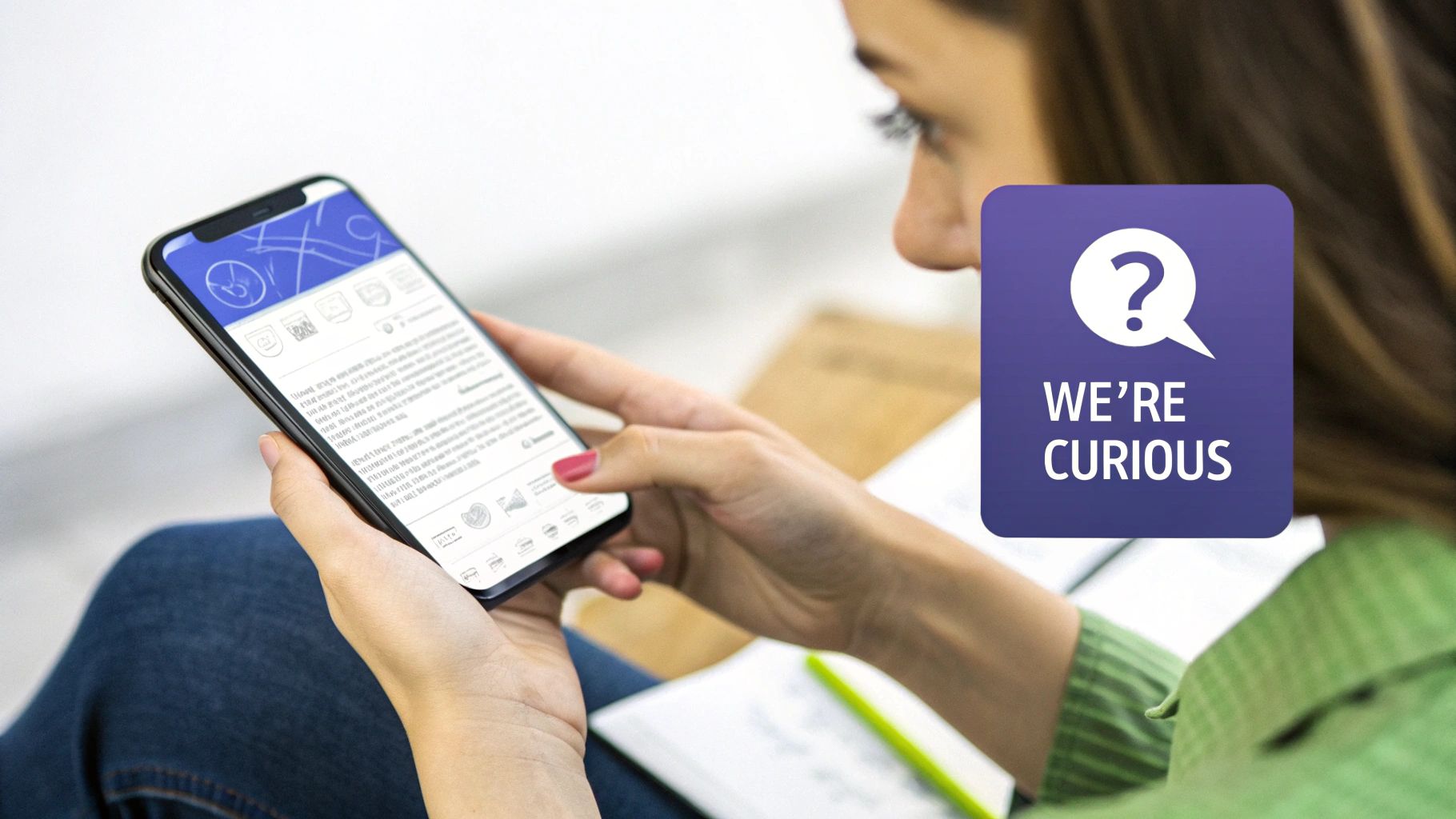
This method transforms a simple request into a community-driven initiative. Instead of asking for a favor, you're inviting them to join a larger conversation that is already happening. This is especially effective for B2B surveys or within specific customer segments where a sense of shared identity is strong.
Strategic Analysis
The strategy here is to build credibility and reduce the perceived risk of participation by showing that others have already taken the desired action. It taps into the principle of "safety in numbers" and the fear of missing out (FOMO). By mentioning a group the recipient belongs to, you make the request feel more relevant and less like a generic, impersonal blast.
Join 1,000+ other founders in our annual SaaS surveyYour fellow [Industry] professionals have shared their thoughts. What are yours?See how you compare: Share your insights with other [Customer Tier] members
Key Insight: The power of social proof is in its specificity. Vague statements like "many people have responded" are less effective than concrete numbers or clearly defined groups. Highlighting a specific community or a quantifiable number of participants makes the social proof more tangible and persuasive.
Actionable Takeaways
To effectively use social proof in your survey email subject lines, ensure the group you reference is one the recipient strongly identifies with. Authenticity is crucial; only use this tactic when you genuinely have a cohort of participants to reference. Overstating numbers or misrepresenting the group can severely damage trust. The goal is to make the recipient feel like a valued member of an exclusive group, encouraging them to add their unique voice to the collective feedback.
9 Types of Survey Email Subject Lines Comparison
From Opens to Insights: Turning Subject Lines into Strategy
Throughout this extensive listicle, we’ve dissected dozens of high-performing survey email subject lines, moving beyond mere examples to uncover the strategic psychology behind them. The goal was never to just give you a list to copy and paste. It was to equip you with a new way of thinking about that single, critical line of text that stands between you and the invaluable customer insights your business needs to thrive.
The journey from a cluttered inbox to a completed survey is a strategic one, and your subject line is the first, most crucial checkpoint. Mastering this single element is a force multiplier for your entire feedback program.
Core Principles for Crafting Winning Subject Lines
As we've seen across all categories, from direct and time-specified to curiosity-driven and personalized, a few core principles consistently emerge as the bedrock of success:
- Clarity Over Cuteness: While cleverness has its place, a clear and direct value proposition almost always wins. Your recipient should instantly understand what you’re asking and why it matters to them.
- The "WIIFM" Principle (What’s In It For Me?): Every effective subject line answers this question, either explicitly or implicitly. Whether it's a gift card, a product improvement, or simply the chance to be heard, the benefit must be tangible to the user.
- Specificity Builds Trust: Vague requests generate suspicion. Stating the exact time commitment (e.g., "2-minute survey") or the specific topic (e.g., "Feedback on our new dashboard") respects your user's time and sets clear expectations, dramatically increasing the likelihood of a click.
Strategic Insight: The most effective survey email subject lines are not written in a vacuum. They are the result of understanding your audience's motivations, respecting their time, and clearly communicating the mutual value of the feedback exchange.
Turning Theory into Actionable Strategy
Armed with these examples and principles, your next step is to move from passive learning to active implementation. Don't just pick a subject line; build a testing framework.
- Segment Your Audience: A power user who just upgraded might respond better to a "Help us shape our roadmap" subject line, while a new user might be more enticed by a "Quick question about your onboarding?" approach.
- A/B Test Relentlessly: Pit different strategies against each other. Test a benefit-focused line against an urgency-driven one. Test a question against a direct statement. Let your data tell you what resonates with your audience.
- Track Beyond the Open Rate: A great subject line gets the open, but your real goal is the completed survey. Analyze how different subject lines impact not just open rates, but click-through and completion rates as well.
Of course, a brilliant subject line is only effective if your email actually lands in the primary inbox. Technical factors like sender reputation, authentication protocols (SPF, DKIM), and content filtering can undermine your best efforts. To ensure your meticulously crafted emails don't get lost in spam folders, it’s essential to maintain pristine sending practices. Consulting a comprehensive email deliverability guide can provide the technical foundation needed to support your strategic messaging.
Your survey email subject lines are more than just a gateway to a form; they are a reflection of your brand's relationship with its customers. They are your first, and sometimes only, chance to show you value their opinion, respect their time, and are committed to building a better product with their help. Get this right, and you’re not just collecting data-you’re building a loyal community.
Ready to put these strategies into action without the manual busywork? Surva.ai automates the entire feedback lifecycle, from sending hyper-targeted surveys with optimized subject lines to analyzing responses with powerful AI. Stop guessing and start knowing what your customers truly think by visiting Surva.ai to see how our platform can turn your feedback into your biggest growth lever.
